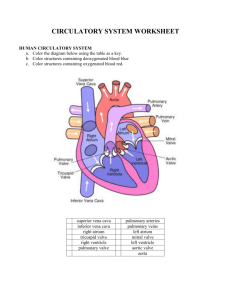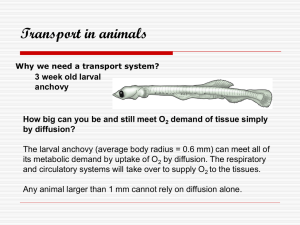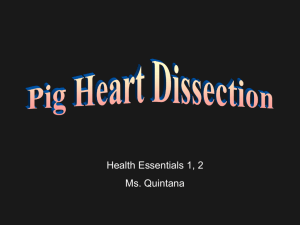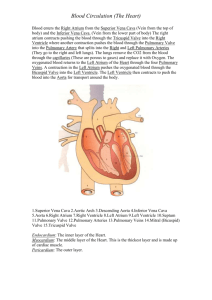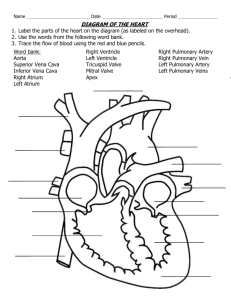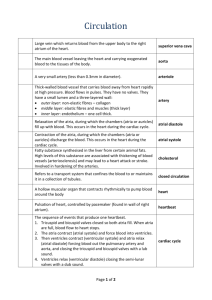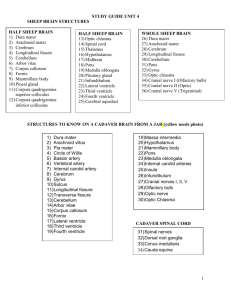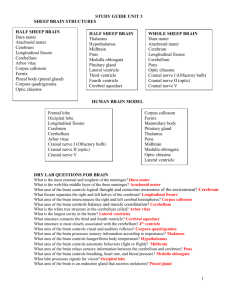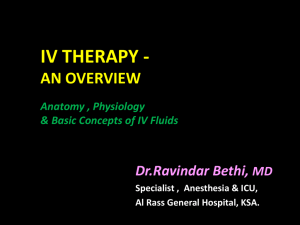Cardiovascular System
advertisement
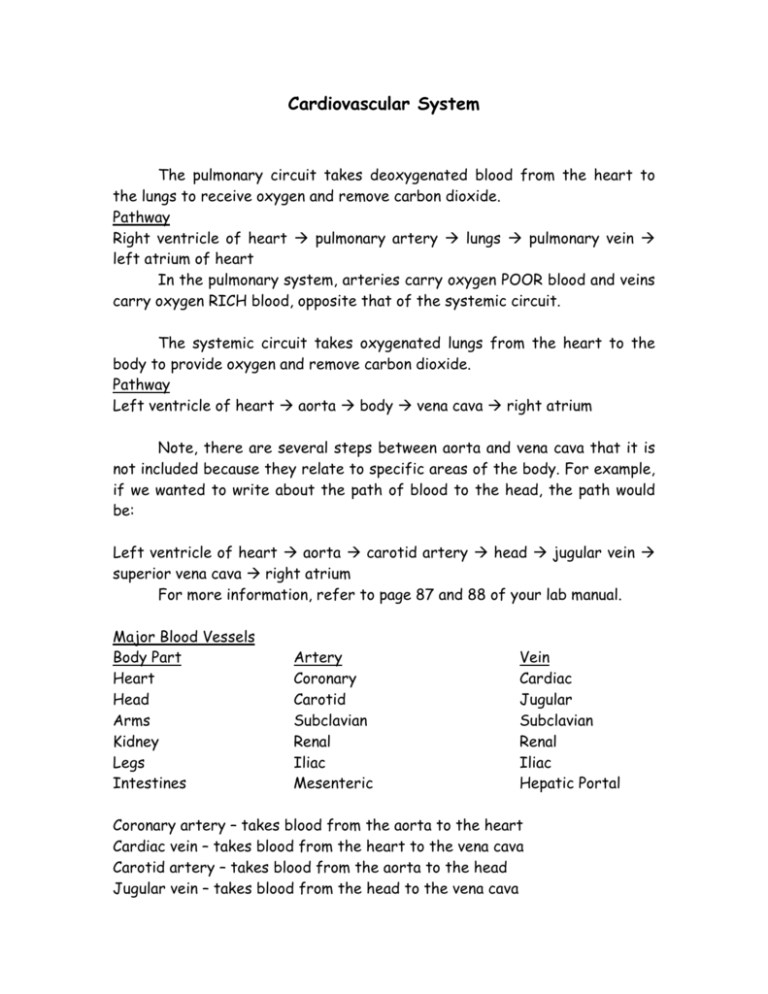
Cardiovascular System The pulmonary circuit takes deoxygenated blood from the heart to the lungs to receive oxygen and remove carbon dioxide. Pathway Right ventricle of heart pulmonary artery lungs pulmonary vein left atrium of heart In the pulmonary system, arteries carry oxygen POOR blood and veins carry oxygen RICH blood, opposite that of the systemic circuit. The systemic circuit takes oxygenated lungs from the heart to the body to provide oxygen and remove carbon dioxide. Pathway Left ventricle of heart aorta body vena cava right atrium Note, there are several steps between aorta and vena cava that it is not included because they relate to specific areas of the body. For example, if we wanted to write about the path of blood to the head, the path would be: Left ventricle of heart aorta carotid artery head jugular vein superior vena cava right atrium For more information, refer to page 87 and 88 of your lab manual. Major Blood Vessels Body Part Heart Head Arms Kidney Legs Intestines Artery Coronary Carotid Subclavian Renal Iliac Mesenteric Vein Cardiac Jugular Subclavian Renal Iliac Hepatic Portal Coronary artery – takes blood from the aorta to the heart Cardiac vein – takes blood from the heart to the vena cava Carotid artery – takes blood from the aorta to the head Jugular vein – takes blood from the head to the vena cava Subclavian artery – takes blood from the aorta to the arms Subclavian vein – takes blood from the arms to the vena cava Renal artery – takes blood from the aorta to the kidneys Renal vein – takes blood from the kidneys to the vena cava Iliac artery – takes blood from the aorta to the legs Iliac vein – takes blood from the legs to the vena cava Path of Blood through the Heart Vena Cava right atrium atrioventricular (AV) valve right ventricle semilunar valve pulmonary artery lungs pulmonary vein left atrium atrioventricular (AV) valve left ventricle semilunar valve aorta Blood Vessel Comparison Arteries carry blood at high pressure (the high pressure being from the heart) and have think walls. Veins move blood via skeletal muscle contractions and require valves to ensure that blood does not backflow, as there is no more pressure from the heart. Veins are more superficial in the body because they require muscle movement to provide pressure to move blood. Arteries already have pressure from the heart, so they do not need to be closer to skeletal muscle. In addition, if a vein is cut, the lower pressure will result in less blood loss than if an artery is severed. For more information, refer to pages 85 and 86 of your lab manual. Blood Cell Comparison Red blood cells (erythrocytes) carry oxygen from the heart to the rest of the body. Hemoglobin is the protein in red blood cells that allows the bonding and release of oxygen. These cells lack a nucleus and are relatively small, but greater in number than white blood cells. White blood cells (leukocytes) are part of the body’s immune system and fight infections in the blood. They are larger and lower in abundance than red blood cells. They do have a nucleus. There are five different kinds of white blood cells – Neutrophils, Eosinophils, Basophils, Monocytes and Lymphocytes. For more information, refer to pages 84 and 85 in your lab manual. Electrical Activity of the Heart The pumping of the heart is controlled by electrical signals sent from the pacemaker, or SA node. After the SA node sends an excitation signal, the atria contract. Once the impulse reaches the AV node, the electrical signal diffuses into smaller Purkinje fibers that signal the ventricles to contract. An electrocardiogram (ECG) illustrates the electrical signals in graphical form, and is what many people are familiar with in hospitals for tracking vital signs. The first wave, the p wave, is small and signals the stimulus of the SA node. Next, the QRS wave is a steep spike indicating the signal has reached the AV node and the ventricles are about to contract. Finally, a smaller T wave shows the ventricles recovering from contraction. For more information, refer to page 81 of your lab manual. Heartbeat Systole - chamber contracts Diastole - Chamber relaxes For more information, refer to page 82 of your lab manual.

